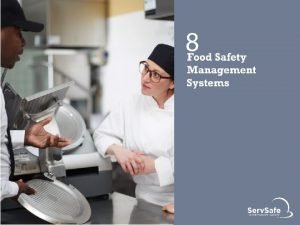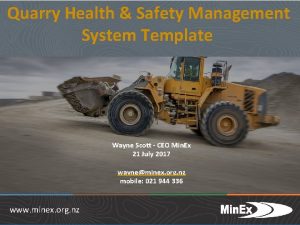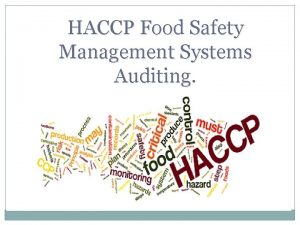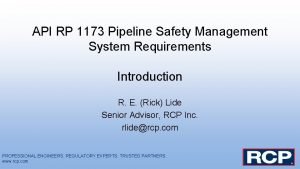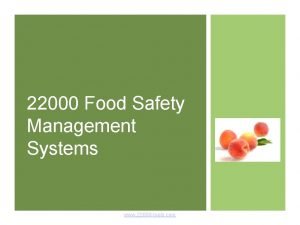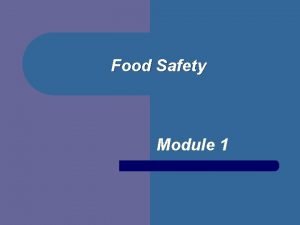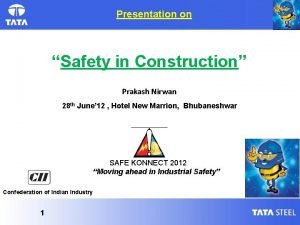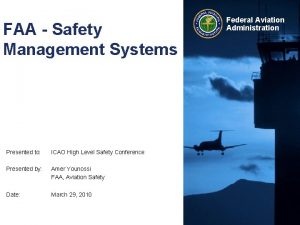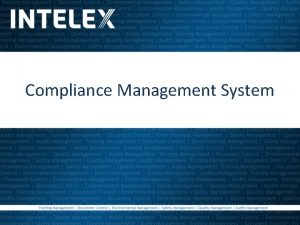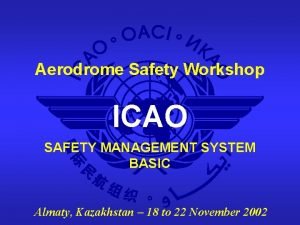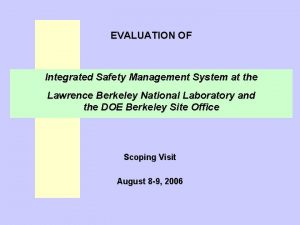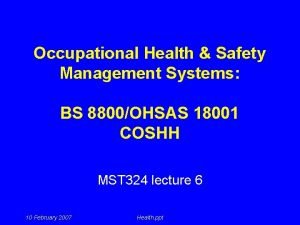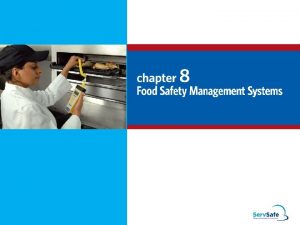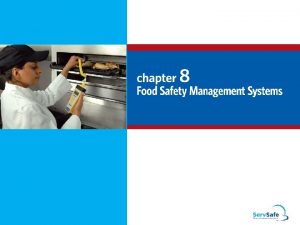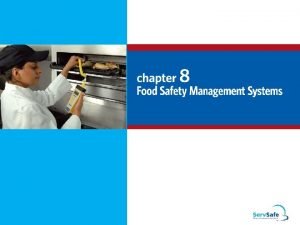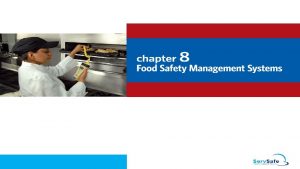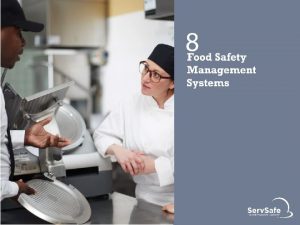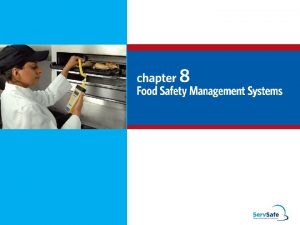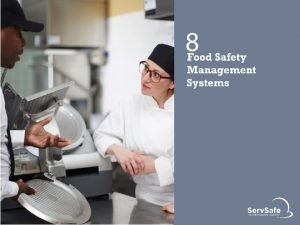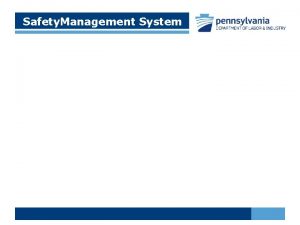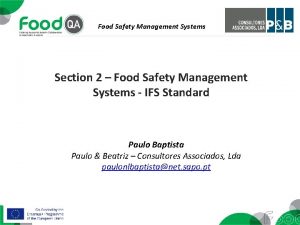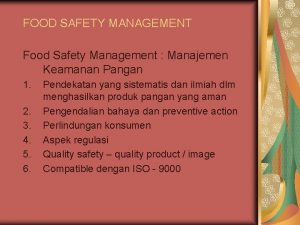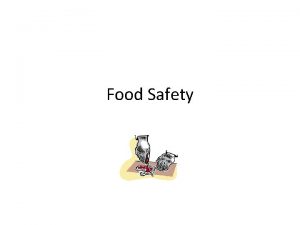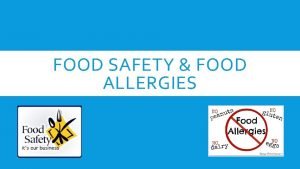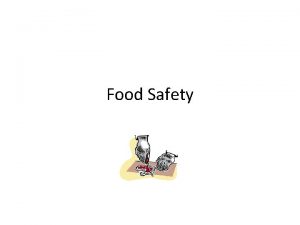Food Safety Management Systems Food management system 8




















- Slides: 20


Food Safety Management Systems Food ______ management system: 8 -2 l Group of practices and procedures intended to prevent foodborne illness l Actively ________ risks and hazards throughout the flow of food

Food Safety Programs These are the foundation of a food safety management system: ________ Food safety training program ________ Supplier selection and specification program 8 -3 Quality control and assurance program

Food Safety Programs These are the foundation of a food safety management system: 8 -4 Cleaning and sanitation program Standard operating procedures (SOPs) Facility design and equipment maintenance program __________________

Active Managerial Control Focuses on controlling the five most common risk factors for foodborne illness: 1. Purchasing food from unsafe sources 2. Failing to ________________adequately 3. Holding food at incorrect temperatures 4. Using _____________ equipment 5. Practicing poor personal hygiene 8 -5

Active Managerial Control There are many ways to achieve active managerial control in the operation: l Training programs l Manager supervision l Incorporation of standard operating procedures (SOPs) l ___________ These are critical to the success of active managerial control: 8 -6 l Monitoring critical activities in the operation l Taking the necessary corrective action when required l Verifying that the actions taken control the risks factors

Active Managerial Control The FDA provides recommendations for controlling the common risk factors for foodborne illness: 8 -7 l Demonstration of knowledge l Staff __________ controls l Controlling ______ as a vehicle of contamination l Time and temperature parameters for controlling pathogens l ___________________

HACCP The HACCP approach: 8 -8 l HACCP is based on identifying significant biological, chemical, or physical __________at specific points within a product’s flow through an operation l Once identified, hazards can be prevented, eliminated, or reduced to ___________________

HACCP To be effective, a HACCP system must be based on a _________: 8 -9 l It must be specific to each facility’s menu, customers, equipment, processes, and operations l A plan that works for one operation may not work for another

The 7 HACCP Principles The seven HACCP principles: 1. Conduct a __________ analysis 2. Determine __________ control points (CCPs) 3. Establish critical limits 4. Establish ____________ procedures 5. Identify corrective actions 6. Verify that the ___________ works 7. Establish procedures for record keeping and documentation 8 -10

The 7 HACCP Principles Principle 1: __________ a hazard analysis 8 -11 l Identify potential hazards in the food served by looking at how it is processed l Identify TCS food items and determine where hazards are likely to occur for each one; look for biological, chemical, and physical contaminants

The 7 HACCP Principles Principle 2: Determine critical control points (CCPs) 8 -12 l Find points in the process where identified hazards can be prevented, eliminated, or reduced to safe levels —these are the CCPs l Depending on the process, there may be more than one CCP

The 7 HACCP Principles Principle 3: Establish critical limits 8 -13 l For each CCP, establish minimum or maximum limits l These limits must be met to o _________or eliminate the hazard o ___________ it to a safe level Critical Limit

The 7 HACCP Principles Principle 4: Establish monitoring procedures l Determine the best way to check critical limits o l 8 -14 Make sure they are consistently met Identify who will monitor them and how often

The 7 HACCP Principles Principle 5: Identify _________actions 8 -15 l Identify steps that must be taken when a critical limit is not met l Determine these steps in advance

The 7 HACCP Principles Principle 6: Verify that the system works l Determine if the plan is working as intended l Evaluate the plan on a regular basis using l 8 -16 o Monitoring charts o _________ o Hazard analysis Determine if your plan prevents, reduces, or eliminates identified hazards

The 7 HACCP Principles Principle 7: Establish procedures for record keeping and documentation Keep records for these actions: 8 -17 l __________ activities l Corrective actions l Validating equipment (checking for good working condition) l Working with ___________ (invoices, specifications, etc. )

HACCP These specialized processing methods require a variance and may require a HACCP plan: 8 -18 l Smoking food as a method to preserve it (but not to enhance flavor) l Using food additives or components such as vinegar to preserve or alter food so it no longer requires time and temperature control for safety l ___________ food l Custom-processing ___________

HACCP These specialized processing methods require a variance and may require a HACCP plan: l 8 -19 Packaging food using ROP methods including o __________ o Vacuum-packed o Sous vide l Treating (e. g. pasteurizing) juice on-site and packaging it for later sale l Sprouting seeds or __________

Variance A ___________ from a regulatory authority will be required before processing food this way. A HACCP plan may also be required if the processing method carried a higher risk of causing a foodborne illness, when a variance is not required. Reduced-Oxygen packaging (ROP) has a high risk of foodborne illness if not done correctly, therefore a HACCP plan is when a variance is in place.
 Active managerial control software
Active managerial control software Safety management system template
Safety management system template Key elements of food safety management system
Key elements of food safety management system Api rp 1173
Api rp 1173 What is food safety
What is food safety 22000 tools
22000 tools Food safety management arkansas
Food safety management arkansas Unit 2 food food food
Unit 2 food food food Eltonian pyramid
Eltonian pyramid Catzoc ecdis definition
Catzoc ecdis definition Safety care certification
Safety care certification Process safety vs personal safety
Process safety vs personal safety Safety assessment for ind safety reporting
Safety assessment for ind safety reporting Basic safety construction site safety orientation
Basic safety construction site safety orientation Basic safety construction site safety orientation
Basic safety construction site safety orientation Contractor safety management system tata steel
Contractor safety management system tata steel Faa approved sms
Faa approved sms Intelex safety management system
Intelex safety management system Aerodrome safety management
Aerodrome safety management Doe integrated safety management
Doe integrated safety management Bs 8800
Bs 8800
